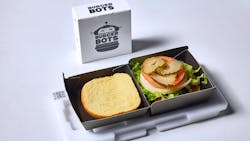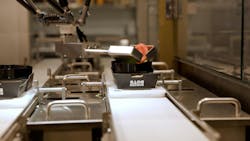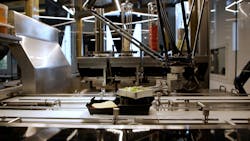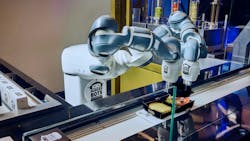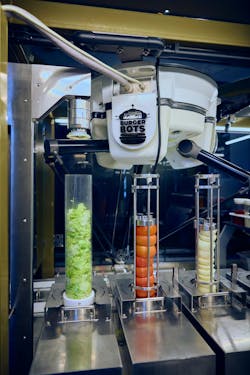Can a Robot Make Your Lunch? Inside the BurgerBots Automated Restaurant
I recently binged "The Bear" (I know, I’m late to the game), and I get it now. It's perfect. The chaos, the relationships, the screaming in the walk-in fridge—it all feels real. While the deepest experience I have in restaurants is a two-month stint as a hostess (I came from retail, so let’s just say the transition was... not smooth), I can appreciate the high-stress, fast-paced world of food service.
Let me tell you, restaurant staff relationships are in a whole different ballpark than retail. There's more intensity, more drama, and in "The Bear", more than enough yelling to make your ears ring. But underneath the drama is a constant struggle: managing food inventory, rising supply costs, understaffing, and trying to get food out fast without losing your mind.
It made me think—automation could be a huge help in real-life kitchens. Not in fine dining, maybe. ("The Bear" is clearly chasing Michelin stars, and I can’t exactly picture a robot delicately plating a micro herb salad.) But in fast food or quick service restaurants, where speed, consistency, and efficiency are non-negotiable? That's a different story.
Robots taking over fast food restaurants and food prep has been a talking point for a while—sometimes framed as fear-mongering about robots stealing our jobs, and other times with that wide-eyed, futuristic "Jetsons" sentiment, wondering when it’ll finally happen. Most of the buzz has leaned toward the former.
There's nothing wrong with augmenting workflows to move things along more efficiently or offering a little extra help when short-staffed. But there’s still a cautious push-pull when it comes to robots, especially in food. And the word "robot" in this context doesn't always mean a humanoid helper or a cobot working side by side with people. Sometimes it just means a machine that can handle a repetitive process.
Take Chipotle, for example. They started using the Autocado to help prep their guac. But it's really just a machine that slices, peels, and pits the avocados for workers. Helpful? Sure. Flashy? Not really.
Wendy's, on the other hand, did deploy underground robots and AI for a new type of "drive-thru" experience to speed up food prep and delivery. And I remember hearing about McDonald's experimenting with automated machines that could make your meal as soon as you punched in your order on a screen. Not sure what happened to those—maybe they're still out there somewhere. Or maybe I've been living under a rock and they've quietly taken over more kitchens. Who knows? (Google would, but that's a problem for later me. I've got writing to do.)
Now, instead of traditional fast-food chains retrofitting their kitchens with automation, there's a whole new restaurant concept designed around robots from the start: BurgerBots.
Launched in Los Gatos, California, BurgerBots uses self-contained, robotic burger-making cells to deliver freshly cooked, made-to-order burgers—without the usual hustle and bustle of a traditional kitchen.
The automated kitchen runs on ABB's IRB 360 FlexPicker and its YuMi collaborative robot, which work together to assemble meals quickly and accurately. The system monitors stock levels and lets staff focus on customer-facing roles instead of line cooking.
"Integrating ABB robots with the BurgerBots restaurant concept demonstrates the incredible potential for automation beyond the factory floor," said Marc Segura, President of ABB Robotics Division. "The food service industry is dynamic and demanding, and our technology brings industrial-grade consistency, efficiency, and reliability to this space. When we asked the hospitality industry, 89% of managers and 73% of workers said they are open to the integration of robotics to automate tasks within their operations.¹ By taking over repetitive and time-consuming tasks, robots allow staff to focus on what matters most—creating memorable dining experiences."
Sure, we've seen robots in food before, but this kind of compact robotic cell setup is a new twist. With two types of robots and real-time inventory monitoring, food prep gets streamlined in a way that feels more intentional and maybe more scalable.
Here's how it works: as each order comes in, the system grabs a freshly cooked patty and places it on a bun inside a burger box. That box sits on a conveyor shuttle tagged with a QR code. As it moves down the line, ABB's IRB 360 reads the code and applies the selected toppings. Then YuMi steps in to finish assembly. The whole process takes around 27 seconds. Not bad.
The setup also uses ABB's robot controller, which can be integrated with non-robotic systems, to track ingredient inventory—things like onions, tomatoes, lettuce, condiments, etc. That kind of backend data visibility is just as valuable as the flashy automation part.
BurgerBots comes from entrepreneur Elizabeth Truong, who sees this concept as just the beginning.
"The vision was to bring consistency, transparency, and efficiency to food service," Truong said. "For restaurant owners, it means better visibility of food costs, more accurate forecasting, and—ultimately—better decision making. In the next five years, I believe that most restaurants will have some form of robotic automation, whether it's back-of-house preparation, assembly, or even front-of-house service. It will become less of a novelty and more of a necessity."
And honestly, it tracks. Since COVID, the restaurant industry has been more volatile than ever. We saw long-standing restaurants close, supply and labor costs spike, and staff turnover rise thanks to pay and scheduling challenges. No one's trying to replace humans entirely—I definitely wouldn't want that—but automation could help bridge a gap that seems to keep widening.
An often-overlooked benefit of robotics in restaurants? Safety. According to a recent ABB-commissioned survey, 65% of workers said they'd welcome robots if it meant a safer work environment.¹ And they've got a point. Kitchens are risky: hot oil, open flames, sharp knives, slippery floors. If robots can take on the repetitive and dangerous tasks, that's fewer injuries and less burnout.
BurgerBots is just one of several food service automation innovations making headlines lately. ABB also partnered with RoboEatz on ARK—an autonomous robotic kitchen that can prepare hundreds of meals with minimal human input. And they're powering Makr Shakr's robotic bartenders, which are already mixing cocktails in venues worldwide.
Whether it's flipping burgers or crafting martinis, robotics is creeping into the hospitality world with speed, hygiene, and consistency.
The first BurgerBots cell is now open and operating inside the Breaking Dawn/First Born restaurant in downtown Los Gatos, California.
And as much as I loved "The Bear" for its raw look at restaurant life, I couldn't help but think: somewhere offscreen, a robot calmly julienning carrots in total silence might've saved everyone a little sanity.
1. Survey of 750 U.S. hospitality managers and 1,250 hospitality workers, conducted by Censuswide for ABB (April 2025).
Fun Innovations Friday
Created by the editors of New Equipment Digest and Plant Services, Fun Innovations Friday is a feel-good blog that showcases how advances in science, math, engineering, and technology are making our world more whimsical. Here’s another post that is guaranteed to brighten your day.
Robotics gets a sweet upgrade with the world’s first edible robot cake
RoboCake isn’t just dessert—it’s a prototype for how edible robots can help solve real-world problems.
About the Author
Laura Davis
Editor-in-Chief, New Equipment Digest
Laura Davis is the editor in chief of New Equipment Digest (NED), a brand part of the Manufacturing Group at EndeavorB2B. NED covers all products, equipment, solutions, and technology related to the broad scope of manufacturing, from mops and buckets to robots and automation. Laura has been a manufacturing product writer for eight years, knowledgeable about the ins and outs of the industry, along with what readers are looking for when wanting to learn about the latest products on the market.
